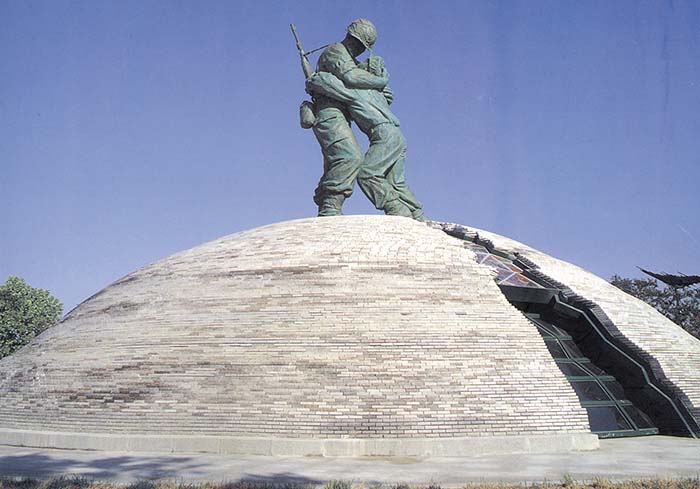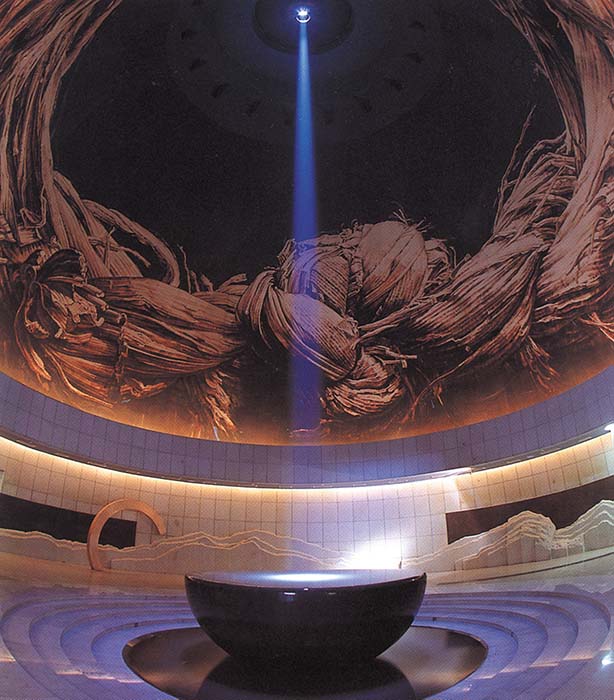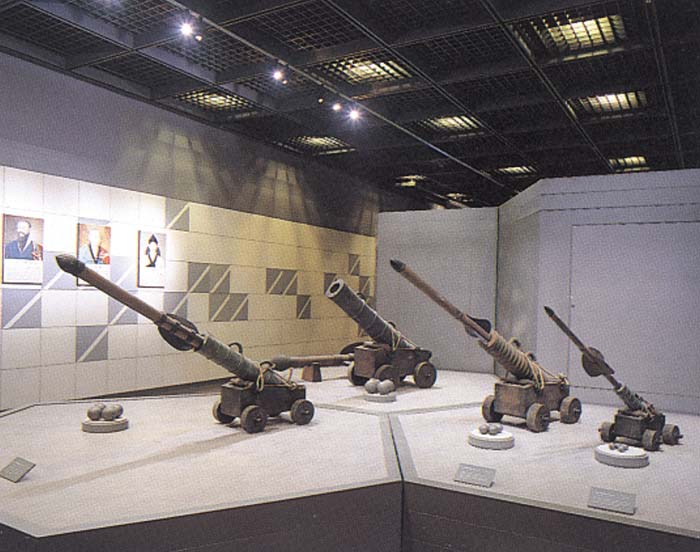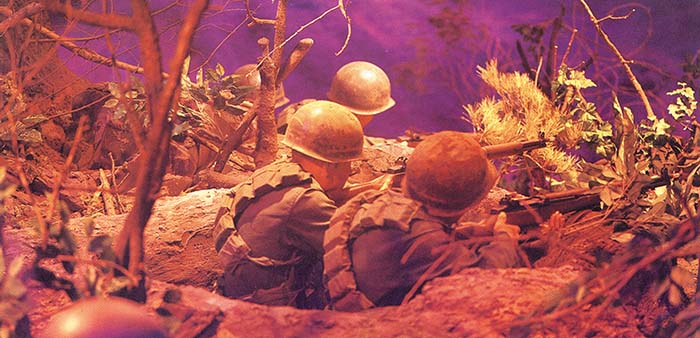1 million square feet of marble, magnificence and memorial to 5,000 years of warriors from Korea. An outdoor exhibit area of aircraft, armament and equipment surrounds the entire facility!
By Michael Shyne
Thirty five thousand American troops and over one-half million Republic of Korea troops, focusing on the joint security area at Panmunjom, face-to-face with the sharp edge of the one million man army of the Democratic Peoples Republic of Korea. Panmunjom, the middle of the demilitarized zone separating South and North Korea, the most heavily armed, heavily mined area of the world. Today, it is still one of the world’s hot spots, after 5,000 years of civilization on the Korean peninsula, after 5,000 years of conflict.

Equal to the magnitude of the arms buildup at Panmunjom, one of the world’s largest military museums, War Memorial in Seoul, Republic of Korea (South Korea) covers the history of life and combat for five millennia. The War Memorial, appropriately located face-to-face with the Republic of Korea’s Ministry of National Defense, is beyond the scope of the concept of a military museum, as we Americans know it. For a country no bigger than Indiana, war, ceremony and honor given to warriors, and the national recognition of the importance of a strong national defense, justifies a museum of this size.
As I approached the War Memorial, I could not believe the magnitude of the architecture. A marble structure of over 100,000 square yards. Quickly I converted that measurement into meaningful numbers. Imagine, a museum of 1 million square feet! Its size is a warning to you. It is not to be visited as a brief stop between breakfast and shopping.
War Memorial is composed of 7 major exhibition halls, honoring the 5,000-year history of the people of this peninsula, as they defended their country from over 900 invasions by neighbors. America’s involvement in Korea since 1866, and our sacrifice of 54,000 American soldiers during the Korean War, as profound and consequential as it was, suddenly shrinks in significance when visiting War Memorial.
A well-planned visit to War Memorial begins in Memorial Hall, architecturally designed to honor and remember the great spirit and the achievement of this nation’s national heroes. Symbolism in Korea is deeply rooted in tradition and carried forward into contemporary architecture, well beyond the accomplishment of American architects. Memorial Hall greets visitors with a circular marble room enclosed with a concave ceiling, honoring a Star Trek-like blue light descending from the ceiling’s apex onto a magnificent hemisphere of marble, the focal point of the room. Nearby, more traditional black marble monuments list the names of Korean officers and soldiers killed in action during the Korean War, South Korea’s proud involvement in the Vietnam War and even in Somalia. As one begins to tour War Memorial, the philosophy of the nation becomes clear: solidarity among its people, and their determination to defend their homeland, is all that separates prosperity and true democracy from communist North Korea’s (the Democratic People’s Republic of Korea) attempt to invade and communize the entire Korean peninsula. The Republic of Korea’s strong national defense is founded on unity and this single-minded focus by its national leadership.

The War History Room includes reproductions of fortresses and dioramas of Korean combat not only with the Japanese and the Chinese in recent times, but in wars that date back to before the Tang Dynasty. Some of Korea’s implements of war are most unique. In fact, they may cause you to realize that modern weapons designers are doing nothing more than “modernizing” the developments of weapon designers of ages past. A model of a Shin Ki-Jon, a multiple rocket launcher is on display. Practically little different than the German Nebelwerfer Portable Rocket Launcher of World War II, this portable, wheeled, multiple launcher sends a cloud of arrows towards its enemy. In the same area cannon are on display. Nearby, are examples of traditional cannon ball, as we are used to seeing in our Civil War battlefields. Yet protruding from the barrels of these ancient cast-bronze cannons are giant Sabot-looking projectiles with fins little different from the air-to-air missiles deployed by America’s contemporary fighter aircraft!

The first exhilarating display of small arms is in the Korean War Room. Keep in mind, the noun “room” is used very differently at War Memorial. For the Korean War Room contains more than a dozen rooms on two floors of this mammoth building. The Korean War resulted in 4.4 million Koreans dead or wounded and 10 million separated from their families. The entire country was devastated. The degree of that devastation is easy for Americans to grasp, for we have many living Korean War veterans. Ask them about their memories of Korea. Ask them if they want to return. Most will tell you the experience was horrible and the nation ugly. Yet today, a visit to South Korea is a visit to a beautiful nation, with 45 million people eagerly wanting to welcome Americans! There are few places on this planet Americans can visit, where one will experience the welcome received in South Korea. The citizens of South Korea clearly recognize their country exists today as a free nation because of the prompt and forceful actions of President Truman and the United States, when North Korean forces, armed and trained by the Soviets, launched an unprovoked, all-out invasion on June 25, 1950, just two years after U.N.-observed elections created Korea’s first democratic government. During my visit to Korea, I was fortunate to be accompanied by a former Korean soldier. This man’s father fought in the Korean War. As explained to me, like virtually all other Korean children of his generation, he was raised with a continued reminder that America and its soldiers (as well as soldiers from 53 U.N. countries) saved South Korea from being overrun by innumerable Chinese troops. My guide’s grandparents suffered the cruelty of the 4-decade long Japanese occupation of Korea. His father fought to save Korea from North Korean dominance. As he explained his family’s history to me, he reached the time of the Vietnam War. He told me there was absolutely no doubt in his mind, and in his family members’ hearts that he would represent his nation, supporting America’s involvement in Vietnam. He explained that military action was an opportunity for South Koreans to attempt to give back to America, as America had so generously given to South Korea between 1950 and 1953.

I have heard from American soldiers who fought with Korean KATUSA (Korean Augmentation to the U.S. Army) troops in Vietnam, describing the Koreans as ultimate warriors. Previously I had thought that their motivation was simply their training. Now I understood that the motivation of Korean soldiers in Vietnam was much deeper, it was rooted in the family tradition of repaying debts owed, even on a global scale. He then told me about the next generation by describing his son’s dilemma. His son was ready to go to college, with a chosen career path and the money to attend college. Yet his father’s challenge was explaining to the son how that plan would have to be put off for a couple of years, while he receives a token monthly payment, serving in the ROK army, meeting the military requirement and fulfilling family tradition.

The Korean War Room is a must-see experience. Along with firearms exhibits are action-filled bronze sculptures and dioramas that allow one to glimpse the struggles of the millions of refugees of that war. I visited this museum with several U.S. Korean War veterans. As we passed a diorama of Chinese soldiers running into battle, one of my friends, almost ashamed, told of how hundreds of unarmed Chinese soldiers descended on them, armed with nothing but pots and pans, hoping to kill Americans and requisition their guns. This Korean War veteran was a youngster when armed Americans were fighting armed Germans in World War II. His understanding of combat was torn apart when he was forced to fire on a swarm of Chinese soldiers coming to beat him to death with kitchen utensils.
As visitors to the War Memorial immerse themselves into the Korean War, a dark doorway awaits them. Beyond that doorway is something seldom experienced in military museums. Beyond that doorway is something two of the Korean War veterans I was with were unwilling to re-experience, for beyond that doorway is the Combat Experience Room. Intellectually described as a place where visitors are able to experience the atmosphere of the real battlefield at night, the Combat Experience Room was much more to the Korean War veterans choosing to accompany me into that darkened environment. We were standing in a foxhole. In front of us were mannequin soldiers crouching down in the heat of battle. Some of the soldiers in front of us were firing M-1 Garands. To our right were two men on a 1919A-4 Browning. Nearby others were firing 60mm mortars into the distance. Separating all of us from the enemy were the battle-scarred remnants of vegetation, entwined with barbwire and destruction. In the distant hills the flash of gunfire pointing our way was constant, as was the roar of automatic weapons fire around us, and the flashes from ordnance exploding nearby. The Combat Experience Room proved too graphic for one of my Korean War friends. Faster than a psychiatrist’s couch, this experience was resurrecting memories he wanted to remain buried. Yet War Memorial’s Combat Experience Room is a great success. It helps successive generations of Koreans feel, on a soul level, the sacrifices made by their parents and their grandparents to create the freedom they unintentionally take for granted.
Ten times in Korean history its troops were sent abroad for participation in other nations’ wars. The Expeditionary Forces Room honors those ten events with particular attention to Korea’s proud participation in the Vietnam War, the Gulf War and the Somalia conflict. In terms of the length and scale of involvement and the role played, its participation in the Vietnam War was the most significant among all ten expeditionary dispatches. Through its participation in the Vietnam War, Korean armed forces displayed their strong might to the world. Its 8-year participation in that war demonstrated to the world that Korean armed forces, which used to receive support from other countries, were now able to provide help to an ally of the free world. Koreans are confident that their involvement in the Vietnam War enhanced the status of the Republic of Korea in the world community by proving to the world that Korea is able to keep its own peace and to contribute towards the peace of the world as well.
We readers of Small Arms Review love to look at guns. But War Memorial carries us beyond that interest, offering us a much deeper understanding of the dangers posed by the enemy. A diorama of Vietcong mines and booby traps, and another of the Vietcong tunnel system, start to reveal the scope of the challenge American and ROK troops experienced during the Vietnam War.
The Armed Forces Room includes halls dedicated to the Army, the Navy and the Air Force, portraying how the Constabulary, which was activated after the liberation of Korea from Japanese colonial rule, transformed itself into the Korean armed forces. With the help of other nations, it ultimately repelled North Korea’s invasion. That trial by fire, just two years after the Republic of Korea was established, began the evolution of the ROK armed forces into today’s military might utilizing up-to-date armament and intensive training of its 600,000 troops.
The next visit is to the Large Equipment Room. In this context, “equipment” fulfills SAR readers’ dreams: helicopters, U.S. and Russian aircraft, tanks, anti-aircraft guns, the big equipment is all here, well preserved in this immense indoor exhibition room.
The final chapter in the statement made by War Memorial is the Korean Defense Industries Room. Here, actual examples and miniature models of weapons and armament currently manufactured in Korea are on display. This exhibit includes small arms, ammunition, electronics and even power plants, all demonstrating the Republic of Korea’s military might and its ability to supply and equip its army and the armies of the world.
One million square feet makes an immense museum. Yet your tour is not over! Leaving the building one enters the next phase of exhibits. The outdoor exhibition area at War Memorial is a grand experience by itself. Imagine Korean, Russian and American aircraft on the grounds surrounding this mammoth marble structure. Would you expect a B52 bomber to be parked in the middle of urban Seoul, Korea? Yet here it is, along with rockets, tanks, and examples of every type of stationary, portable, tracked and naval artillery that one could imagine. I was delighted to be able to photograph the missing pieces to my 90mm anti-aircraft gun. You will find something equally meaningful if you take the trip to South Korea and visit the nation that is eternally extending its hand of friendship and thanks to America.
| This article first appeared in Small Arms Review V4N12 (September 2001) |











